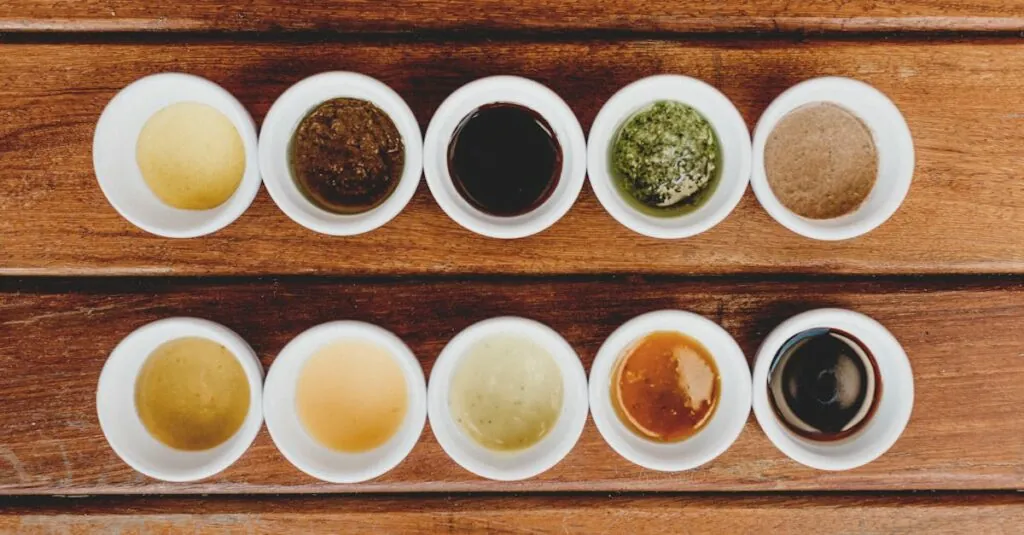Table of Contents
ToggleCooking isn’t just about tossing ingredients together and hoping for the best. It’s an art form that transforms simple foods into mouthwatering masterpieces. With a variety of cooking methods at their disposal, chefs and home cooks alike can elevate their culinary game from “meh” to “wow” faster than you can say “bon appétit.”
Types Of Cooking Methods
Cooking methods vary greatly, each offering unique flavors and textures. Understanding these methods allows cooks to select the best approach for their dishes.
1. Baking
Baking involves cooking food in an oven using dry heat. This method is ideal for items like breads, cakes, and casseroles.
2. Boiling
Boiling consists of cooking food in water or broth at high temperatures. It works well for pasta, vegetables, and eggs.
3. Steaming
Steaming cooks food using water vapor. This technique retains nutrients, making it perfect for vegetables and fish.
4. Grilling
Grilling cooks food over direct heat, usually from a grill or open flame. This method enhances flavors, particularly in meats and vegetables.
5. Sautéing
Sautéing involves cooking food quickly in a small amount of oil or fat over high heat. It’s commonly used for vegetables and small cuts of meat.
6. Frying
Frying uses oil to cook food, which can create a crispy texture. This method includes deep frying and pan frying, suitable for foods like chicken and potatoes.
7. Roasting
Roasting cooks food evenly in an oven, often at high temperatures. It is excellent for meats and root vegetables, providing a caramelized surface.
8. Braising
Braising combines both dry and wet heat cooking methods. It typically involves searing meats and then cooking them slowly in liquid, which yields tender results.
9. Poaching
Poaching cooks food gently in simmering water or broth. Eggs and delicate fish benefit from this technique.
10. Sous Vide
Sous vide entails vacuum sealing food and cooking it in a water bath at precise temperatures. This method ensures consistent results and enhances flavors.
Exploring the various cooking methods expands culinary skills and enables cooks to elevate their dishes. Each method contributes distinct qualities to food, allowing for creative expression in the kitchen.
Dry Cooking Methods
Dry cooking methods utilize heat without moisture, intensifying flavors and enhancing texture. Techniques such as roasting and baking shine in this category.
Roasting and Baking
Roasting involves cooking food evenly in an oven, resulting in caramelization and browning. Vegetables and meats benefit from this method through enhanced flavors and appealing appearances. Baking primarily focuses on breads, pastries, and casseroles, allowing ingredients to rise and develop a crust. Temperature control, typically between 300°F and 500°F, is crucial for both techniques. For instance, roasting a chicken at 425°F yields a juicy interior and crispy skin. Both methods foster creativity and allow for experimentation with spices and marinades.
Grilling and Broiling
Grilling exposes food directly to heat, creating distinctive charred marks and smoky flavors. Common items for grilling include meats, vegetables, and seafood. Temperatures can vary, but high heat generally ensures quick cooking and searing. Broiling, in contrast, uses radiant heat from above, cooking food quickly while promoting browning. Vegetables benefit from both methods, absorbing rich flavors that enhance presentation. For effective grilling, maintaining consistent temperatures between 400°F and 600°F is vital. Meanwhile, broiling often occurs at 500°F or higher, making both techniques suitable for preparing various dishes efficiently.
Moist Cooking Methods
Moist cooking methods incorporate water or steam to enhance flavors and retain nutrients in dishes. These techniques often produce tender results and highlight the natural tastes of ingredients.
Boiling and Simmering
Boiling involves cooking food in water at 212°F, leading to fast results and soft textures. Simmering, on the other hand, occurs at lower temperatures, around 185°F to 205°F, allowing foods to cook gently without breaking apart. Vegetables, grains, and pasta benefit from both methods, becoming tender and flavorful. Using boiling for pasta provides an ideal base for sauces, while simmering soups extracts deep flavors from ingredients. Mastering these techniques enables cooks to effectively manage various ingredients and enhance culinary outcomes.
Steaming
Steaming utilizes water vapor to cook food, preserving nutrients and moisture. This method operates at temperatures just below boiling, usually around 212°F. Fish, vegetables, and dumplings thrive in this environment, maintaining vibrant colors and textures. Utilizing a steamer basket or an electric steamer offers convenience while ensuring even cooking. Steamed vegetables often exhibit a crisp-tender quality that enhances their natural flavors. Cooks achieve healthier dishes without added fats, making steaming an excellent choice for nutritious meals.
Combination Cooking Methods
Combination cooking methods blend dry and moist heat to enhance flavors and textures in dishes. These techniques often lead to rich, tender outcomes.
Braising
Braising involves slow cooking food in a small amount of liquid. Typically, this method starts with searing meat at high temperatures, followed by transferring it to a covered pot with liquid like broth or wine. This process allows for flavor integration and moisture retention. Cooking at low temperatures, usually between 250°F and 300°F, ensures meat becomes tender over time. Braised dishes, such as pot roast or coq au vin, often yield a celebrated depth of flavor and improved texture.
Stewing
Stewing entails cooking smaller pieces of food submerged in liquid. Ingredients like meat, vegetables, and spices combine in a single pot. Cooking occurs at low temperatures, generally around 180°F to 190°F, which facilitates even cooking and creates a cohesive dish. Stews like beef bourguignon or vegetable stew showcase rich, hearty flavors as they simmer. The long cooking time enhances the melding of ingredients and results in a satisfying meal ideal for various occasions.
Alternative Cooking Methods
Exploring alternative cooking methods can enhance culinary experiences. Unique techniques like sous vide and microwave cooking offer efficient and flavorful solutions.
Sous Vide
Sous vide operates by cooking food in a vacuum-sealed bag submerged in a water bath at precisely controlled temperatures. Cooking at low temperatures, generally between 130°F and 190°F, allows for even doneness throughout the food. This technique retains moisture and enhances flavors, particularly in meats and vegetables. Sous vide results in tender, juicy dishes that maintain their original color and nutrients. Chefs often complete sous vide cooking with a quick sear to develop a flavorful crust.
Microwave Cooking
Microwave cooking uses electromagnetic radiation to heat food quickly and efficiently. The process involves water molecules absorbing energy, causing them to vibrate and generate heat. Cooking times vary based on food type and portion size but it often results in reduced preparation and cooking times. Vegetables often retain their nutrients better due to shorter cooking durations. This method provides convenience for busy kitchens without sacrificing taste in many dishes.
Mastering various cooking methods can elevate anyone’s culinary skills. Each technique offers unique advantages that can transform ordinary ingredients into extraordinary dishes. By experimenting with dry and moist methods as well as alternative techniques, cooks can discover new flavors and textures.
Understanding how to apply these methods effectively empowers both novice and experienced chefs to get creative in the kitchen. Whether it’s the rich flavors from braising or the health benefits of steaming, there’s a cooking method for every preference and occasion. Embracing these techniques not only enhances the cooking experience but also brings joy to the art of preparing meals.







